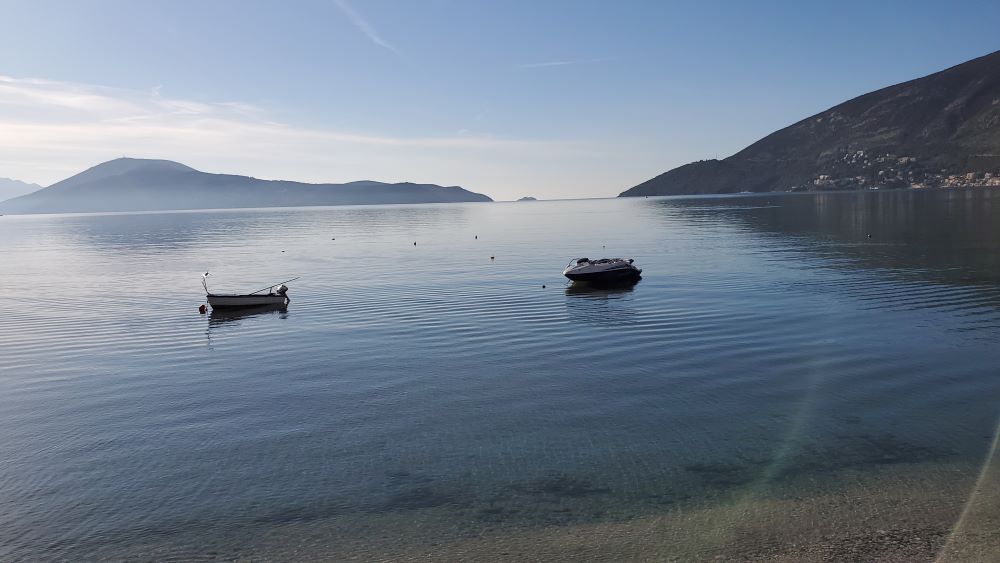Montenegro Pulse contains affiliate links and is a member of the Amazon Services LLC Associates Program. If you make a purchase using one of these links, I may receive compensation at no extra cost to you. See my disclaimer for more information.
Weather in Montenegro in February: What to Wear, What to Pack, and More Visiting Tips
BY SARAH
The weather in Montenegro in February is some of the coldest of the year, but we get brilliantly sunny winter days that are perfect for heading outdoors.
The coast’s Mediterranean climate means it’s relatively mild throughout winter. The northern region has a continental climate, so it’s much colder.
If you are planning to visit both, you will need to pack for both climates.
On this page, you’ll learn more about what to expect from Montenegro weather in February. You’ll also find tips on what to pack, what to wear, and some of the best things to do in Montenegro in February.
Typical Weather in Montenegro in February
Coastal Areas
- Average High in February: 13°C (55°F)
- Average Low in February: 6°C (43°F)
- Average Monthly Rainfall: Approximately 162 mm (6.4 inches)
- Average Sea Temperature in February: 14°C (57°F)
In February, Montenegro's coast can be cold but brilliantly sunny. The average temperature ranges from 6°C (43°F) to 13°C (55°F).
February often means sunny, but freezing days, as the bura wind blows down from the snowy mountains. There are also beautiful sunny days where you can enjoy the outdoors in just a light jacket or sweater.
 A clear, calm February day in the Bay of Kotor
A clear, calm February day in the Bay of KotorThis weather is perfect for strolling along the seaside and enjoying outdoor cafes, as long as you’re dressed appropriately.
I recommend taking a Kotor walking tour through the old town to see the highlights. If you have more time, this highly-rated jeep tour takes you to a traditional village to try local cuisine.
On wet days, take a trip to Lipa Cave, Kotor Bay Aquarium, and the Roman Mosaics in Risan.
Podgorica
- Average High in February: 12°C (54°F)
- Average Low in February: 3°C (37°F)
- Average Monthly Rainfall: Approximately 170 mm (6.7 inches)
In February, Podgorica sees a slight increase in temperature, with averages ranging from 3°C (37°F) at night to 12°C (54°F) during the day.
This month brings a mix of sunny days and rain, so it's good to plan for both outdoor and rainy day activities.
On sunny days, you can take a city tour, take a walk along the Ribnica River, take a sightseeing tour to Ostrog Monastery and Lake Skadar, or visit the wild animal sanctuary.
On rainy days, you can visit the city museum, enjoy a traditional meal at Niagara restaurant on the Cijevna River and visit the Cathedral of the Resurrection of Christ (Hram Hristog Vaskrsenja), a large Serbian Orthodox church.
Northern Region
- Average High in February: 5°C (41°F)
- Average Low in February: -3°C (27°F)
- Average Monthly Precipitation: Approximately 192 mm (7.6 inches)
In February, Montenegro's northern region remains in the grip of winter. You can expect temperatures to hover around -3°C (27°F) to 5°C (41°F), with even colder nights.
It’s usual for this region to be covered in snow in February, making it ideal for winter sports like skiing and snowboarding.
Kolašin, near Biogradska Gora National Park, is home to Montenegro’s top ski resort, Kolašin 1450 and 1600.
There is also a smaller ski resort in Žabljak, near Durmitor National Park, called Savin Kuk.
What to Pack for February in Montenegro
Coastal Areas
In February, the Montenegrin coast offers milder weather, but you'll still need to dress warmly.
Opt for layers: start with a long-sleeved top, add a sweater for insulation, and top it off with a warm jacket.
You’ll need comfortable, waterproof shoes for rainy days. I also recommend packing a hat, gloves, and sunglasses for those sunny but cold days when the bura wind blows.
Packing List for the Coast of Montenegro:
- Long-sleeved tops
- Warm sweaters for layering
- Waterproof jacket
- Medium-weight jacket for evenings
- Jeans or trousers
- Waterproof shoes or boots - I live in these Sorel boots over winter in Montenegro. They’re warm, waterproof, comfortable, and stylish!
- Hat and gloves
- Sunglasses
- Plug converter - I like this power strip converter that can handle several devices at once. It’s ideal for families bringing multiple devices!
- Travel insurance - this is a must when traveling to Montenegro. Not only will it cover things like lost luggage and flight delays, but more importantly, any medical issues that you might have.
Montenegro’s public health system is rather poor, so I always recommend going private if you have any issues while you’re here and travel insurance will cover that.
Having medical evacuation cover is essential in Montenegro because if you have any serious issues you may need to be transported to another country.
I like Safety Wing’s Nomad Insurance (you can buy it just for a trip) because it’s the best value and most comprehensive cover I’ve found so far.
What Not to Pack:
- Hair straightener/curling irons - In Europe, the voltage is 220, while in the US and Canada, it’s 110. Most electronic devices such as cell phones, laptops, and electric shavers are dual voltage by default, so you can use them with a simple plug converter.
Unfortunately, hair straighteners and curlers use very high wattage and do not usually come with a dual-voltage setting, which means they won’t work in Europe.
Or rather, you’ll fry your appliance and short-circuit your hotel room!
If you can’t use your own hair appliances, your best option is to bring a dual-wattage straightener that will work in Europe and North America.
Inland Regions
In February, Montenegro's inland regions are still cold, often with snow. Dress in warm layers. Start with thermal underwear, followed by a fleece or wool sweater, and finish with a heavy, insulated coat.
Waterproof, insulated boots are essential for keeping your feet warm and dry. Don't forget a warm hat, gloves, and a scarf to protect against the cold.
If you plan to enjoy outdoor activities, consider moisture-wicking layers to stay dry and comfortable. Sunglasses are useful for bright, sunny days.
Packing List for Inland Montenegro:
- Thermal underwear
- Fleece or wool sweater
- Heavy, insulated coat
- Waterproof snow pants
- Warm sweaters
- Waterproof, insulated boots with good grip
- Warm hat
- High-quality gloves
- Scarf
- Moisture-wicking layers (for outdoor activities)
- Sunglasses
Top Things to Do in Montenegro in February
- Skiing and snowboarding: Head to one of Montenegro’s ski fields to make the most of the cold weather. Savin Kuk near Žabljak and Kolašin 1450 and 1600 near Kolašin are Montenegro’s top ski fields, but there are also small fields called Vučje and Hajla.
- Kotor Bay Aquarium: this family-friendly attraction in Kotor is a great activity for rainy days. Inside, you’ll find small but beautifully curated displays of Kotor Bay sea life. The touch pool with rays is a highlight! Find out more about the aquarium here.
- Mimosa Festival: Herceg Novi’s annual Mimosa Festival runs for two weeks and includes free fish and wine on the seaside in Baošići, a masked ball, wine and flower shows, concerts, and a carnival-type parade.
- St Tryphon's Day: Make sure you head to Kotor Old Town on Febrary 3rd for St Tryphon’s Day, which celebrates the city’s patron saint. You’ll be able to listen to traditional music and see one of the world’s oldest groups, the Boka Navy, perform their traditional dance. Read more about Kotor old Town here.
- Ostrog Monastery: Take a day trip to Ostrog Monastery, an incredible monastery built into the side of a cliff and one of the Balkans’ holiest sites. Plan your trip to Ostrog Monastery here.
- Lipa Cave: Lipa Cave is a family-friendly attraction you can visit any time of year. Combine it with a visit to Cetinje, Montenegro’s old royal capital and the national museums. Find out more about visiting Lipa Cave here.
- National Museum: The national museum is made up of several buildings in Montenegro's old royal capital, Cetinje. Visit the main museum, Bilijarda, and King Nikola's Court all in one place. Find more details here.
More Fun Things To Do In February
Hotel Deals
February is low season in Montenegro, so it’s a great time to find some deals on accommodation. While many places close down over winter, those that stay open offer great rates.
Click the links below to visit Booking.com or VRBO to find a great deal and read recent guest reviews before you book.
Booking.com: Find great deals all over Montenegro for your upcoming stay!
Vrbo: Find a comfortable vacation rental through VRBO and feel more like a local. Find some great places to stay on VRBO here.
- Home
- The Climate of Montenegro
- Weather in Montenegro in February








